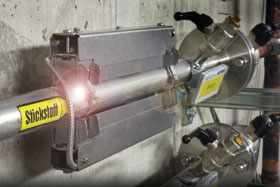

Boehringer Ingelheim produces and markets medical products worldwide and is amongst the world’s 20 leading pharmaceutical companies. The company is represented worldwide by 145 affiliates and employs a total of more than 42 000 people.
Problem description
Nitrogen is required in many processes of the chemical and pharmaceutical industry, predominantly as a protective gas to prevent the occurrence of explosive atmospheres, such as when handling dusty products or solvents. At the Ingelheim plant, nitrogen is provided centrally, as is compressed air. Two tanks with liquid nitrogen ensure a continuous supply and the expanded gas feeds to a pipe system, from which consumers draw required amounts of nitrogen. While the amounts that are fed in are recorded using gearwheel meters, there were no consumption measurements up until now. Therefore, when the new production facility was constructed, engineers wanted to add the capability to record consumption rates in order to determine actual demand, to identify any possible savings potential and obtain empirical data as a basis for future plans. Utmost cleanliness is required in pharmaceutical applications and the nitrogen fed into the ring system has the highest quality level 5.0, corresponding to a purity of 99.999%. Any possible contamination therefore had to be prevented at all costs.
If the pipeline has to be opened for work, it means an extended shutdown of production in all connected systems. Once installation work has been completed, the nitrogen network must undergo a detailed sampling inspection by the department responsible for qualification and validation. Production can be resumed only after the required purity level has been certified. The technicians in charge were therefore looking specifically for a non-invasive measuring technique to perform consumption measurements. Non-invasive flow measurement with the Fluxus G ultrasonic measuring system proved to be the ideal solution. Since clamp-on transducers are simply mounted on the outside of the pipe, there is absolutely no risk of contamination, and modifications made to the measuring point do not have any effect on the production process. Now the individual consumers, which are supplied via six lines in the building, can be measured successively using non-invasive technology. Another positive side effect of the flow measurements is the simple determination of possible leaks: nitrogen is an odourless gas, which is why small leaks in the network generally go unnoticed. If a flow rate is now measured in one line while there is no nitrogen being consumed, and the system is in operating mode, a leak can definitely be identified.
Measuring task
Flow measurement of nitrogen in pharmaceutical production:
• Medium: nitrogen (pharmaceutical quality 5.0).
• Pipelines: DN 32 to DN 35.
• Material: stainless steel, copper.
• Temperature: 15 to 20°C.
• Pressure: 8 bar.
Instruments used
Fluxus G 704 with clamp-on ultrasonic transducers.
According to the operators, the advantages and benefits that accrued on the plant included:
• Reliable, non-invasive volume flow measurement for precise recording of individual consumers.
• External non-invasive measurement: absolutely no danger of contaminating the ultra pure gas flow.
• No plant shutdown for installation or subsequent extensive re-qualification of the plant.
• Simple, gradual recording of all consumers with just a single clamp-on measuring system.
• Determination of the extent of leakages.

© Technews Publishing (Pty) Ltd | All Rights Reserved